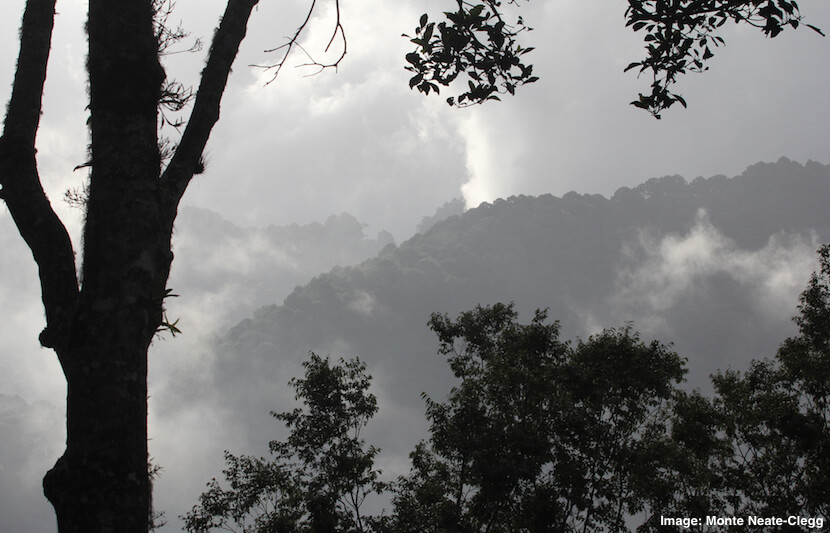Bird species in the cloud forests of Honduras are losing their habitats and forced to move to higher elevation because of climate change and deforestation, a new study suggests.
This 10-year study signals a real possibility of extinction for some of the world’s most unique species.
The paper is published in the journal Biotropica.
Situated high up in mountains and surrounded by low-level clouds, a cloud forest is an ecosystem that drinks up moisture directly from clouds.
Walking into this misty, evergreen place, you will almost believe that you have just crossed the bridge to the forest kingdom of Terabithia.
Accounting for only 1 percent of the world’s forests, cloud forests have the highest level of botanical and biodiversity.
“Cloud forests are pretty special,” Monte Neate-Clegg, the lead researcher and a doctoral student at the University of Utah, said in a statement. “The tropics hold most of the world’s biodiversity to begin with, and then the mountain slopes hold the greatest biodiversity within the tropics.”
Cloud forests in Cusuco National Park, Honduras, he cited as an example, is home to at least six amphibian species that are not known in any other parts of the world.
The park also supports species large and small — from jaguars to hummingbirds.
“Cusuco National Park is montane cloud forest, a rich diverse ecosystem full of specialized species making it important to monitor,” said Neate-Clegg.
The real world steps in
Sadly, even in this magical place, something reminds us of the real world — the rising temperature.
In 2012, a team of researchers warned that climate change will likely wipe out 90 percent of Mexico’s cloud forests and as many as 70 percent of its plant and animal species by 2080.
Species living in mountainous regions may be more sensitive to climate change because of various factors affecting community assembly across elevational gradients.
Moreover, scientists, including Çağan Şekercioğlu, an associate professor of biology at the University of Utah and the study’s co-author, predicted that rising temperatures and changes in precipitation would cause species, particularly birds, to shift to higher elevations, shrinking their habitat and boosting the risk of extinction.
In addition to the rising temperature, cloud forests receive little practical protection from deforestation and land conversion.
“Climate change is a big threat to them as well as deforestation, which is removing habitat at lower elevations,” said Neate-Clegg.
The study
Realizing the dire consequences, Neate-Clegg and his colleagues, including researchers from the UK and Belgium, examined 10 years worth of data of bird species counts in Cusuco National Park.

Operation Wallacea, a conservation organization that Neate-Clegg joined in 2015, started collecting the data in 20016 by point counting from 115 different locations every year.
According to Neate-Clegg, during a point count, the observer stands for 10 minutes and records all of the bird species seen or heard.
Because it is difficult to spot birds in dense forests, all of the ornithology team were trained to be able to identify the bird species of the park, especially from their calls and songs.

The findings
They found most species moving upslope, at an average of 23 feet (7 meters) per year. Beyond species-specific changes in elevation, the researchers focused on bird diversity along the mountain slopes.
“By looking across all species we could show that the diversity was increasing at higher elevations and decreasing at lower elevations,” Neate-Clegg said in a statement.
According to Neate-Clegg, although no one can yet clearly prove why birds are shifting upslope, climate change has a hand in it.
“It is difficult to say what exactly is causing birds to shift upslope. Multiple studies around the world have now documented it, including this one, but the direct cause has not been tested. The consistency of the observation, across the tropics and in degraded and undegraded forest indicates global climate change and this matches up with the theory,” he said.
“We know that every species has a niche, which includes both the environmental and biological variables to which that species is adapted. The idea is that as temperatures warm, the ideal temperature for each species moves higher upslope, and that the species will themselves move upslope to follow it.”
Whether temperature plays a direct role or an indirect one has not yet been determined though.
“However, we don’t yet fully understand whether it is a direct role of temperature in determining elevational ranges or whether ranges are determined by microhabitat, food availability, disease etc which are in turn mediated by temperature,” he said.
Additionally, the researchers believe the continuing development and deforestation is another factor to the shift.
“Every year we go back and resurvey, and transects that were forested the previous year are suddenly cut down,” Neate-Clegg said in a statement. “They are encroaching year on year.”
The terrain’s status as a national park, he says, doesn’t seem to be much of a deterrent for those seeking to expand agricultural land.
Possible solutions
According to Neate-Clegg, possible solutions are land protection and global efforts to slow and halt climate change.
Protected areas should “encompass not only species’ present distribution, but also their future distribution under climate change. So for mountain species, it is important to protect whole elevational gradients so that species can move upslope unhindered,” he said.
As for climate change, Neate-Clegg advises everyone first does his part.
“Anyone can make a difference by eating less meat, cycling to work, switching lights off,” he said.
Neate-Clegg will continue studying how tropical montane birds respond to climate change.
“I am investigating multiple avenues, including changes in demographic rates (e.g., survival) and species distributions in Africa, and I am interested in what consistencies there might be in species responses across the tropics,” he said.



